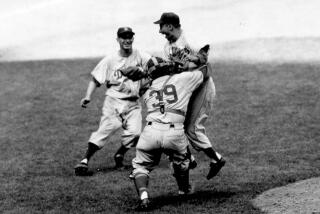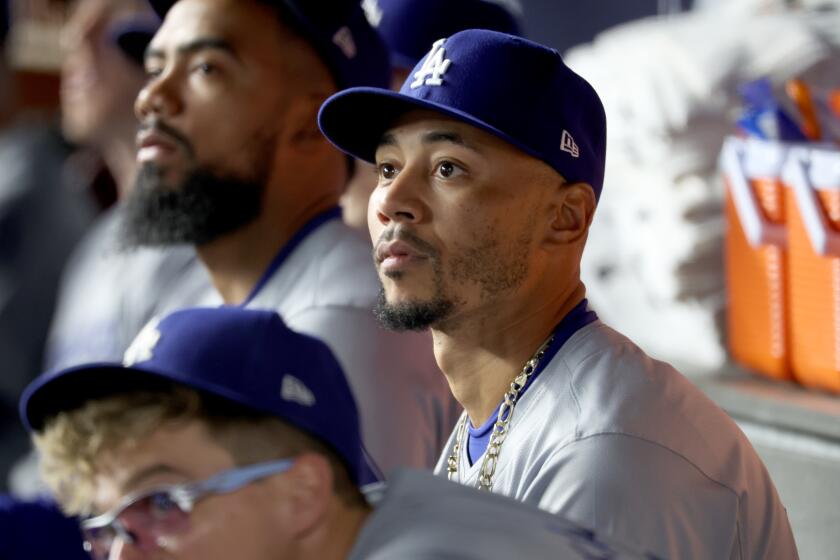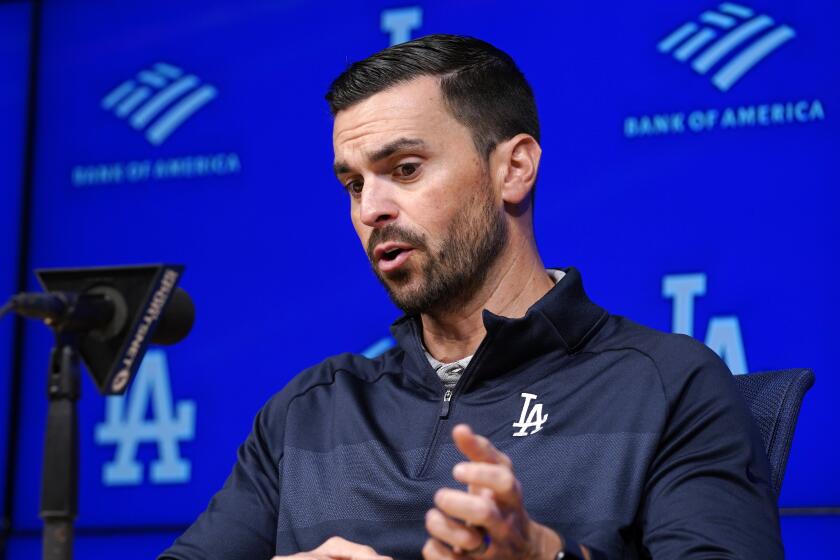Carl Furillo, Dodger Outfielder for 15 Seasons, Is Dead at Age 66
Carl Furillo, the Dodgers’ right fielder during the 1940s and ‘50s, died Saturday at his home in Stony Creek Mills, Pa. He was 66.
Furillo was born and raised in Stony Creek Mills, just outside Reading in eastern Pennsylvania, and moved back to that area not long after his baseball career ended in 1960.
Furillo played his entire 15-year career with the Dodgers in Brooklyn and Los Angeles, taking part in seven World Series, with the Dodgers winning two.
Furillo finished with a career batting average of .299, with 192 home runs and 1,058 runs batted in. His best season was 1953, when he won the National League batting title with a .344 average despite missing the last few weeks of the season with a broken hand.
Furillo was known as the Reading Rifle because of his powerful throwing arm. Roy Campanella, the Dodgers’ catcher during most of Furillo’s career, said Saturday: “He had the best throwing arm of any right fielder I ever played with or against.
“I’m really sorry to hear he’s passed away. He was quite a good friend.
“There were seven of us who played every day, and he was one of them.”
Besides Campanella and Furillo, the others were Gil Hodges at first base, Jackie Robinson at second, Pee Wee Reese at shortstop, Billy Cox at third and Duke Snider in center field.
Vin Scully, the Dodgers’ longtime announcer, said of Furillo: “He was basically a no-nonsense, blue-collar player who played hard and played every day. He was very strong, and I can’t stress enough how hard he played.”
However, baserunning wasn’t one of his strengths.
“I guess you’d call him a cautious baserunner,” Scully said. “That’s why his nickname among his teammates was Skoonj, which was short for the Italian word meaning snail.
“He was a quiet man, so it was strange that he would be involved in two of the Dodgers’ major skirmishes back then.”
The most memorable was in 1953, when Furillo and New York Giants Manager Leo Durocher tangled.
“The preamble to that came earlier (in 1951),” Scully recalled. “Before a Dodger-Giant game, I was walking with Carl along a dirt path under Ebbetts Field, from the clubhouse to the Dodger dugout, when we came across (Giant coach) Herman Franks.
“Franks warned Furillo he’d better watch out, and Carl shouted something back at Franks. Then, in the game, a pitcher by the name of Sheldon Jones beaned Furillo, I mean, really beaned him.
“Late in the 1953 season (Sept. 6, to be exact), Ruben Gomez, a screwball pitcher for the Giants, hit Furillo.
“Furillo went down to first and glared at Leo in the dugout. Then he motioned to him with his index finger to come out and fight, sort of saying, ‘Come on, come on.’
“Leo in turn motioned Carl to come in. The two met halfway, and Carl got Leo around the forehead and put a lock on him like you wouldn’t believe. If he’d got him around the throat, he would have killed him. And I’m not speaking figuratively. I mean actually killed him.
“Leo’s bald head turned maroon before anybody could get to them. Both benches cleared, and everyone dove on the two of them. Carl ended up on the ground and someone stepped on his hand. That’s how he broke it.
“Later on, I don’t recall the exact year, with the rivalry still as bitter as ever, a Giant pitcher named Sal Maglie, who they’d called the Barber because of the way he shaved people (with close pitches), threw at Furillo.
“Furillo in turn threw his bat at Maglie. It sailed out to the pitcher’s mound on a line about knee high. Fortunately, Maglie jumped and cleared the bat. That led to another bench-clearing brawl.
“Coincidentally, Maglie was traded to the Dodgers (in 1956), and he and Furillo were assigned to room with each other. They eventually became good friends.”
When the Dodgers moved from Brooklyn to Los Angeles in 1958, they asked Furillo, then 36, to come with them to help promote the team.
Though Furillo appeared in only 50 games in 1959, he played a major role in Los Angeles winning its first World Series.
Before the Dodgers played the Chicago White Sox in the World Series, they met the Milwaukee Braves in a one-game playoff. After Furillo tied the game with a sacrifice fly in ninth inning, he hit a high, twisting grounder in the 12th that shortstop Felix Mantilla gloved behind second base. Throwing off balance, Mantilla bounced his throw past first baseman Frank Torre as Hodges scored the winning run and led to Scully’s famous call: “We go to Chicago.”
One week into the next season, Furillo tore a calf muscle. Shortly thereafter, the Dodgers, wanting to bring up a young prospect named Frank Howard, gave Furillo his release.
Furillo sued the Dodgers to collect the remainder of the $30,000 contract, and won.
After a couple of years of living in New York, he moved back home to Pennsylvania. And he cut himself off from baseball for 20 years, rejecting all invitations to old-timers’ games.
But finally, about 9 years ago, Peter O’Malley, the Dodger president, made a special invitation, which Furillo and his wife accepted.
Eventually, Furillo worked as an instructor at the Dodgers’ adult fantasy camps in Vero Beach, Fla.
He most recently worked as a security guard for a nylon factory in Stony Creek Mills but had been in poor health in recent years.
Furillo is survived by his wife, Fern Reichart Furillo, and two sons, Carl A. Furillo Jr., of Temple, Pa., and Jon M. Furillo, of Stony Creek Mills, as well as five grandchildren and two sisters.
His brother, Nicholas, 70, a minor league player, died Jan. 4.
Roger Kahn, in his book, “The Boys of Summer,” wrote: “I cannot imagine Carl Furillo in his prime as anything other than a ballplayer. Right field in Brooklyn was his destiny.”
More to Read
Are you a true-blue fan?
Get our Dodgers Dugout newsletter for insights, news and much more.
You may occasionally receive promotional content from the Los Angeles Times.









